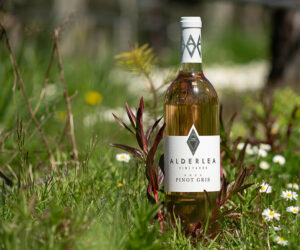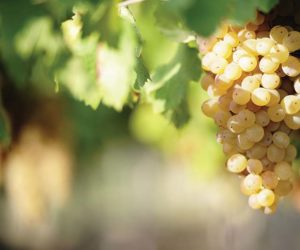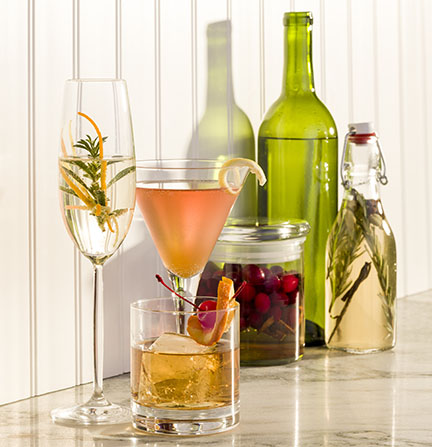
Aperitif: More a culinary term than a specific beverage. We use the word in English in almost exactly the same way as its original in French — they differ by only an accent mark, with the French spelling apéritif. The Concise Oxford Dictionary says it is an “alcoholic drink as appetizer,” reflecting the word’s ultimate Latin origin in aperire, to open. In European use such a beverage was thought to “open” the digestive system and stimulate the appetite for an imminent meal. Who am I to argue with that?
At their rise of popularity in the early- to mid-20th century, most featured aperitifs were one or another of existing dry white wine styles including brut sparkling wine, fino and manzanilla Sherry, Mösel up to a harvest sugar level of Spätlese (second from lowest among six German gradations), and Chablis. Other wine-based beverages have joined the aperitif application over the years, including a number of them that are flavored with herbs, fortified with additional alcohol, or both. The Oxford Companion to Wine notes that Catalan alchemist Arnaldus de Villanova (Arnaud de Villeneuve) received a patent from the king in 1299 for the distillation of wine alcohol and its use to stop fermentation to make sweet, fortified wine. In 17th century London, Samuel Pepys made a reference to “a glass of wormwood wine.” He was referring to the tonic that got its name from wormwood, Wermuth in German. Infused into wine, sometimes fortified and sometimes sweetened, the bitter Wermuth gave us Vermutwein and ultimately the drink we now call vermouth. Some famous aperitifs contain no wine at all and are legally classified as liqueurs. In 1851, Gaspari Campari developed the well-known Italian aperitif that bears his name. It is made from alcohol and water, infused with herbs and fruit. Another famous Italian aperitif is Aperol, originated in 1919 by the Barbieri Company but now a Campari product as well. It is notable for its use in a popular cocktail, the Aperol Spritz. Cocktails of this kind can themselves be used in an aperitif role to stimulate the appetite.
Infused & Fortified Wines
Among all these choices, I find the infused and fortified wines to be most fun to make as aperitifs at home. I always start with one of my homemade dry wines and then build the aperitif from there. It makes me feel like I have accomplished dual DIY goals when I use a homemade beverage to make another homemade beverage! (I also put homemade wine in the meat mixture when I make salami, but that’s another story.) Commercially, producers of fortified aperitif wines are faced with a number of legal restrictions. Depending on jurisdiction, they are often required to meet a level of at least 18% alcohol by volume (ABV) and no more than 24%. Further, when making an alcohol addition, they must use a distilled spirit derived from the same general source as the base wine they are modifying. That is, grape wines need to be fortified with grape alcohol. Although producers sometimes refer to this addition as “brandy,” it is more likely to be a clear high-proof product known as grape spirits. For use in fortification, bonded wineries can purchase grape spirits distilled at levels as high as 190 proof (95% ABV). For home winemakers, that spirit can be difficult to find. It may even be illegal for home winemakers to add high-proof spirits to wine and if you face that condition you may need to add sugar (chaptalize) the original fermentation to achieve a sufficient alcohol level in your finished aperitif.

Fortunately, there are commercial alternative spirits for sale. While you could use brandy, typically 80 proof (40% ABV), it will add the aroma, flavor, and brown color that come from aging in an oak barrel. Grape spirits can be used for a more neutral addition. You may be able to find products such as Cîroc vodka made from French grapes and selling for about $30 a bottle or JCB Vodka from Jean-Charles Boisset and made from Burgundy wine grapes, selling for about $130 a bottle. Both are 80 proof, meaning you add a considerable amount of water when you make your fortification. And while I very much enjoyed a recent opportunity to taste several of the excellent JCB spirits at the Spirited Magazine trade tasting and show in Santa Rosa, California, I doubt that I will be putting such a premium product into my homemade aperitifs. Instead, I forego the “grapes with grapes” rule and use grain neutral spirits instead. Brands like Everclear and Diesel are available in various states at 151, 153, or 190 proof, meaning much less added water when you fortify. These beverages are about $20 a bottle, so a relative bargain for a home project. If you use one of these, keep in mind that ethanol at this level is highly flammable!
Calculations
When I make an aperitif wine, I first choose the style that I want to achieve. In the October-November 2014 WineMaker I described a dry vermouth that I made (among other fortified wines). For my most recent projects, I decided to try a sweet vermouth based on Pinot Noir and an entirely original cranberry-Viognier aperitif. For any such project, the first practical step is determining the alcohol level of the base wine so you can calculate the amount of spirits needed to fortify to your desired end ABV. You can have your wine analyzed at a wine testing laboratory, as I did for these projects, or you can estimate your wine’s ABV based on harvest data. If you finish fermenting the base wine completely dry, you can multiply the starting Brix number by a factor of 0.55 to get a very close approximation of the final alcohol. This is the method I used in my dry vermouth project a few years ago, yielding an estimate of 12% ABV. The other data points you must have in hand are the ABV of the spirit you will use (for that project it was Diesel grain neutral spirits at 153 proof or 76.5%), the desired final alcohol level for your aperitif (I chose 18%), and the volume of your batch (I made 1 gallon/4 L).
My method is to make these calculations, infuse my fruits, herbs, or spices in a bit more than the necessary amount of distilled spirits, then run that infusion through a paper coffee filter. At that point, I can assemble my blend. I leave it for a week or two to verify stability. The blended product may need to be cold stabilized (by holding it in the refrigerator for a week or two) or fined or filtered. Finally, I do back sweetening trials, sweeten, and bottle. For the most recent projects we took one more step and made some experimental cocktails with the new aperitifs.
The calculations all come down to use of a device called Pearson’s Square. It is often displayed in a grid like this:
A D
C
B E
Where:
A = ABV, distilled spirit
B = ABV, base wine
C = Target ABV for fortified wine
D = C – B, parts spirits
E = A – C, parts wine
For that previous dry vermouth project, that means:
D = 18 – 12 = 6 parts spirits
E = 76.5 – 18 = 58.5 parts wine
The next challenge is to turn those “parts” into useful measures to make a specific volume of aperitif. Here’s how: 6 plus 58.5 means we have a total finished amount containing 64.5 parts. To spread that across one gallon, we can work in ounces: 128 oz. in a gallon. To find out how big a “part” is, divide 128 by 64.5 = 1.98 ounces per “part.” Rounding off the trivial differences to two ounces per part, we see:
6 parts spirit x 2 oz. per part = 12 oz. (350 mL) of Diesel distilled spirits
58.5 parts wine x 2 oz. per part = 117 oz. (3.4 L) of wine
To allow for small losses in filtering the infused spirits, I started with 14 oz. (414 mL) in a one-pint (0.5-L) Mason jar. The finished vermouth was a bit cloudy, so I fined with Sparkolloid from Scott Laboratories before bottling in 375 mL wine bottles. A dry, colorless (or faintly green) vermouth like this is considered the “French” style, whereas the darker, sweet vermouth is called “Italian.” I gave bottles of my dry vermouth to friends and relatives who reported enjoying it in a number of aperitif applications. It was tasty chilled and served “neat,” poured over ice in an old-fashioned glass, or made into a classic gin or
vodka martini.
Making Sweet Vermouth
When I set out to make some more aperitifs, I knew I wanted to involve my daughter and son-in-law, Charlotte and Pete Mattice, in the sweetening and cocktail trials. Just as dry vermouth is used in a martini, sweet vermouth is employed in making a whiskey-based Manhattan cocktail. Charlotte and Pete favor the darker spirits like whiskey and dark rum over the lighter ones, so it was time to try my hand at sweet vermouth! Sweet vermouths are proprietary products from many different producers. Dozens of herbs, spices, or dried fruits may be included in a recipe. The finished alcohol is around 16% and residual sugar may run as high as 16%. I wanted to lean heavily on “brown” spice aromatics and keep the sweetness fairly moderate. To do my calculations, I had an analysis run by ETS Laboratories in Healdsburg, California, on my 2016 estate Pinot Noir. The results came in at 13.2% ABV. I chose Diesel spirits at 76.5% ABV and decided to try for 16% ABV in the final vermouth. That results in Pearson’s numbers
like this:
A = 76.5
B = 13.2
C = 16
D = 16 – 13.2 = 2.8 parts Diesel spirits
E = 76.5 – 16 = 60.5 parts Pinot Noir
Calculating for one gallon as in the first example, 2.02 oz./part can round off again to 2 oz. per part. That yields 5.6 oz. (166 mL) infused spirits to be blended with 121 oz (3.6 L) Pinot Noir. To allow for a small loss upon filtration, I used 8 oz. (237 mL) of Diesel in a Mason jar.
For aroma, I wanted an assertive fruity and spicy lift, with no single note dominating. I had not worked with whole nutmeg before so I asked a longtime fermentation collaborator of mine, Kimi Anderson, how many of them she thought I should crush and infuse. She said even one crushed would likely overwhelm my other spices and advised soaking just one, whole. She was right — the nutmeg note is identifiable, though not dominant, from just that one. I also knew I needed some bitterness in the flavor to offset the eventual sweetening. While wormwood is authentic in vermouth, it is hard to obtain and a bit controversial as an ingredient. Instead, I bittered with dried mugwort, an ingredient I used in my dry vermouth and which I have used for bittering a homebrewed beer without hops. Here’s the infusion recipe:
6 g bitter orange peel
3 g dried mugwort
2 g anise seed, lightly crushed
1 stick cinnamon
1 g cloves, lightly crushed
3 g coriander seed, lightly crushed
1 whole nutmeg (~6 g)
1 vanilla bean, split and scraped into the infusion
2 g whole allspice
After soaking these ingredients in the dark for a week, I ran the infusion through a coffee filter and made the blend. The resulting aperitif remained very clear, so I neither fined nor filtered it. Since Charlotte and Pete live in Hawaii and I live in California, I bottled a 750 mL bottle unsweetened and took it with me for trials. To cover the range of likely sweetnesses, I added sugar to separate 100 mL samples at 4%, 8%, and 12%, along with an unsweetened control sample. Enticing aromas of Christmas baked goods and sweet vanilla rose from the control, but the lack of sugar allowed the bitterness to dominate the flavor to an unpleasant extent. Both 4% and 8% were pleasant, aromatic, and fairly well balanced. At 12%, it was too sweet, with suppressed aromas and what Pete called “cough syrup” flavors. We did a spontaneous pour-together of the 4% and 8%, liked it, and settled on 6% for the final product. It retained the delightful spice and vanilla aromas while sweetness balanced the bitter flavors beautifully.
Cranberry Viognier Aperitif
For my other aperitif, I was inspired by a famous cocktail, the Aperol Spritz. Recipes usually combine sparkling wine and Aperol aperitif in equal volumes, with a splash of soda. Aperol itself includes bitter orange, gentian, rhubarb, and cinchona as some of its flavor and aroma components. For my aperitif, I wanted fruity aromas while still having a balancing bitterness. I decided to use my 2016 Sierra Foothills Viognier as a base, since the wine itself is aromatic and has a slight bitterness in the finish. To get both fruit and bitterness, I decided to use cranberries. For bright aromas, I added dried lemon and bitter orange peels. For the base wine, the lab results said 13.8% ABV and I selected 17% for my finished product. That led to 6.4 oz. (189 mL) Diesel and 119 oz. (3.5 L) Viognier. Once again infusing 8 oz. (237 mL) I used:
6 oz. (170 g) coarsely chopped raw cranberries
6 g dried bitter orange peel
6 g dried lemon peel
After a week of infusing, I filtered the deep red spirits blend and mixed it with the Viognier. The resulting aperitif was pale pink, fruity, and slightly bitter. It also had a nice aromatic brightness with the citrus peel notes coming through. With much lower bitterness than in the vermouth, I set up sweetening trials at 2%, 4%, and 6%. Everyone found the unsweetened control unpleasantly bitter and the 6% too sweet and candy-like. Some of my four test subjects (my wife Marty White, along with Pete and Charlotte) preferred 2% and others 4%, so we compromised on 3%. Sweetening the remainder to that level, we set out on the aperitif cocktail quest (see recipes below).
Sweet Vermouth:
Ni’ihau Nectar
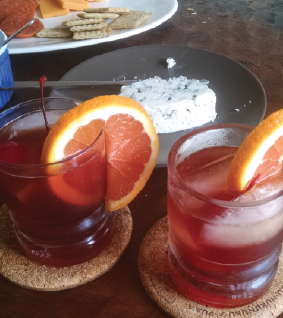
Since we were in Hawaii (we could see Pearl Harbor from the kitchen table where we did the trials), all the cocktails wound up with island or nautical names. For this one, we added a slice of fresh blood orange to a fairly traditional Manhattan to make the Ni’ihau Nectar
Ingredients
2 oz. (59 mL) homemade sweet vermouth
2 oz. (59 mL) Bourbon whiskey
2 dashes Angostura bitters
Thick blood orange slice
Notes
Measure vermouth and whiskey into an old-fashioned glass and stir. Fill with ice. Top with bitters and garnish with orange slice.
We found the fresh, sweet orange aroma made a very pleasing balance with the spiciness of the vermouth. The whiskey was also nicely complemented by the spices.
Cranberry Viognier Aperitif:
The Ocean Spritz
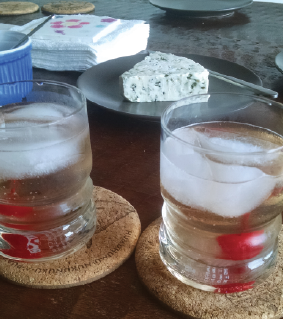
The first cocktail made with the cranberry Viognier aperitif is my homage to the Aperol Spritz that started me down this path. We named it The Ocean Spritz.
Ingredients
2 oz. (59 mL) homemade cranberry Viognier aperitif
2 oz. (59 mL) Prosecco or other light sparkling wine
Splash soda
Maraschino cherry
Notes
Pour over ice in an old-fashioned glass and garnish with a maraschino cherry.
We found this cocktail light and refreshing. It was gently fruity with good balance. It resembled other sparkling wine cocktails like Aperol Spritz itself or a Kir Royale.
Cranberry Viognier Aperitif:
Sunken Sailor
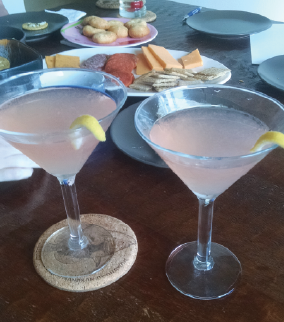
For this one, we were experimenting with adding herbaceous notes from gin and bitters while still keeping the fruit from the aperitif and some lemon juice, creating the Sunken Sailor.
Ingredients
2 oz. (59 mL) homemade cranberry Viognier aperitif
1 oz. (30 mL) gin (local craft distiller’s if available)
3⁄4 oz. (22 mL) fresh lemon juice
Dash Angostura bitters
Lemon peel
Notes
Combine with ice in a cocktail shaker. Shake and strain into a stemmed cocktail glass; garnish with a lemon peel twist.
We found the tart lemon gave this cocktail a very refreshing counterpoint and the pink aperitif made it seem a bit like an adult pink lemonade. Very distinctive and unusual flavors, unlike any other cocktail any of us had tasted.



